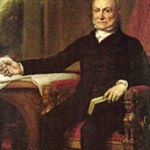In 2006, Ford Motor Company hired Alan Mulally to be CEO and President. The hiring of a former Boeing executive outraged several of Ford’s management team, but Chairman William Clay Ford, Jr. wanted somebody from outside the company. He was trying to break idea that hiring within the business is best for business, and create an environment susceptible to change. Within a few months of being hired, Mulally started planning to reshape Ford.
Rather than jump into a plan, he involved management of all levels by asking several questions regarding why focus shifted away from the Ford brand. When they didn’t have an answer, retrenchment was his strategic approach. He began reducing the number of the company’s luxury brands by selling Jaguar and Land Rover in order to focus on and improve the Ford brand. He also financed some of the company in order to raise capital for the upcoming change.
Ford’s strategic approach proved to be successful. During the U.S. auto crisis period, it was the only auto company of the “Big Three” not to seek financial assistance from the government. Ford has adapted the idea of dealing with the world the way it is, rather than what they wish it would was. Before the hiring of Alan Mulally, Ford saw where the company was heading had it stayed on the same path. Without a change, they would have followed suit and sought government assistance during the auto crisis period. They would have reacted to their external environment after it affected their internal environment. Though the external environment of a company can not be directly controlled by a company, understanding its warnings can assist that company. Therefore, Ford prepared for the effects of the external environment by strengthening their internal. Ford’s attention to these effects prompted its executives to seek effective change. Since they knew a long-time employee would likely keep things the same, they hired from outside their work force.
First, they distinguished business symptoms from problems and acted upon them. Symptoms were a decline in sales and profits, while problems were managers waiting to be told what to do and how consumers felt about the quality of Ford products in the U.S. Involving various levels of management in decision-making alleviated the first problem. Since they were involved in the process, managers could act faster rather than waiting for decisions to filter down. They are better prepared for the change and not caught off guard with employees’ potential resistance. Lower level management can implement the change more effectively by having time to prepare.
Involving managers also revealed that Ford had meetings about meetings. In other words, mid-level management would have a meeting about how to present information to top-level management at a later date. This process was eliminated when Mulally removed the barrier between levels of management by developing mutual trust. Establishing mutual trust between different levels of management allows for less resistance to change.
Ford’s retrenchment strategy was highly effective because it cured the problem the company had with consumers’ view of a quality product. Consumers wanted an automobile that when brought in for trade wouldn’t be far less than expected. With Jaguar, Land Rover and other brands being phased out, focus is automatically drawn to those remaining. A company with fewer products can focus on what a consumer views as quality of those products. Ford refocused on its core competencies and reduced brands from eight brands to four. This allowed Ford to produce a more quality product within those four brands. Since more levels of management were involved in the implementation of the plan, the plan was that much more effective. Consumers want their version of a quality product and Ford is giving it to them, thus Ford’s symptoms are disappearing as problems are effectively addressed. Their market share currently sits at 17%.
At the time of Mulally’s hiring at Ford, General Motors (GM) didn’t have a contingency plan. They even kept the same management during the period of the auto crisis and were forced to seek aid from the government. GM did little to change their internal environment at the time. They hired a new president/CEO from within their work force. Things didn’t begin to turn around until Edward Whitacre was brought in with help of the Obama Administration. This forced a change to GM’s internal environment, but didn’t cause typical resistances to surface. Whitacre was a blunt man who had no problem retrenching the company. Like Ford, his plan was to refocus and restructure the company for survival.
Whitacre determined that GM’s problem was too many brands and unnecessary management. With Whitacre, GM saw that their level of quality wasn’t drastically affecting the company, but rather having too much to choose from and not focusing on what customers were asking for. They followed Ford in selling four of its eight brands to focus on customer demands. But unlike Ford, GM focused on it overseas market. While Ford sought to improve U.S. sales, the future of GM relies on their ability to tend to its Asian market.
The Wuling Sunshine cost $9000 at most and is exactly what Chinese customers want. Almost 600,000 were sold last year, and it is the top selling vehicle in the world. Because GM recognized their cash cow and its location, with retrenchment Whitacre was able to refocus the company and invest where successful. This strategic approach reduces unnecessary distractions and provides focus where needed. A company with less to worry about is a company with more means to deliver quality. Though it may not have the top selling automobile in the U.S. or Europe, it does have the top selling automobile in the world. This guarantees survival of the company and the success of this strategy can be applied to other parts of the company as well as other countries.
GM’s retrenchment approach also involved a restructuring of departments and agile managers. Whitacre first fired CEO Fritz Henderson. The company needed change and a longtime GM employee wasn’t deemed radical enough. A drastic yet positive change at top level management will result in a drastic yet positive change down the chain. Whitacre then combined GM’s marketing and sales departments in an effort to minimize excessive personnel and maximize personnel potential. This was achieved by firing one department head and placing the other in charge of the new combined department. A good manager utilizes his personnel in a way that maximizes productivity while not sacrificing personnel well-being. Whitacre wants his managers and department heads to make decisions quickly and correct mistakes even quicker. This helps a manager to better deal with sudden changes that may be passed down, as well as sudden changes caused by the company’s external environment. Though agile managers in themselves are not a contingency plan, the agility of managers is crucial when facing unwanted change. Those managers who did not live up to standards where dismissed. For GM, fear for job security, instead of mutual trust, was used to motivate managers and employees.
Another part of GM’s strategy involved reshaping marketing. Whitacre believes that a company who adapts to the needs of business is a smart company. Commercials that pay little attention to the product being sold can’t expect to bring in sales. Consumers need to know they are purchasing a quality product. Therefore, GM took celebrities out of its commercials and spent time explaining the product. After consumers gained faith back in GM products, sponsors were strategically selected. For example, professional football is well known to be linked to tailgate parties. GMC sought the NFL to be an official sponsor of one of the NFL’s programs, and used this to promote truck sales during prime NFL segments. Effective advertising a product is good management practice and helps consumers believe that the company has faith in its product. It also markets the product to the proper target base. GM applied retrenchment strategies to its products, departments and management.
Both Ford and GM are becoming successful again. Ford had a better sense of forecasting and was proactive before the crisis. Their ability to respond to the change of their external environment helped save them from taking drastic measures. Though GM took advantage of the bailout plan, they have since been effective using a plan similar to Ford’s, however more autocratic. Their forced change displayed a need in the company to survive. When that changed proved to be in the best interest of consumers, GM began to rebound. They have realized their core competencies, refocused on them, and are effectively utilizing them. Their internal environments have strengthened over the years by improving their weak links.
There is no clear winner or loser in this case. Both companies are focused on their most profitable asset in their respective regions. Ford is gaining a strong control of the market within the U.S. Consumers in the U.S. see the strength Ford displayed during trouble times and their ability to pull through. They also see the focus Ford has on developing a product their customers view as quality. On the other hand, GM is capitalizing on its Asian market while trying to regain a foothold in the U.S. Ford is giving their customers what they want, just so happens their market rest overseas. As long as they are responsible for the top-selling car in the world, they will survive.
Bibliography
Paul Ingrassia. “How Ford Is Making Its Comeback. ” Wall Street Journal 5 Nov. 2009, Eastern edition: ABI/INFORM Global, ProQuest. Web. 2 Oct. 2010.
Welch, David. “Ed Whitacre’s Battle to Save GM From Itself. (cover story).” Bloomberg Businessweek 4177 (2010): 48-55. Business Source Complete. EBSCO. Web. 3 Oct. 2010.
Muller, Joann. “Can China Save GM? (cover story).” Forbes 185.8 (2010): 72-78. Business Source Complete. EBSCO. Web. 3 Oct. 2010.
Ritson, Mark. “Ford’s clarity of focus.” Marketing (00253650) (2009): 22. Business Source Complete. EBSCO. Web. 3 Oct. 2010.
Kiley, David. “FORD’S SAVIOR?.” BusinessWeek 4123 (2009): 30-34. Business Source Complete. EBSCO. Web. 3 Oct. 2010.
Taylor III, Alex. “CAN GM SURVIVE? (cover story).” Fortune 160.7 (2009): 60-62. Business Source Complete. EBSCO. Web. 3 Oct. 2010.



